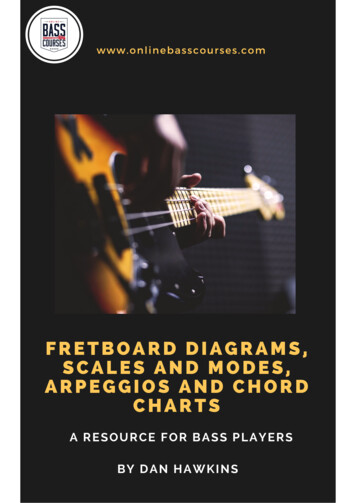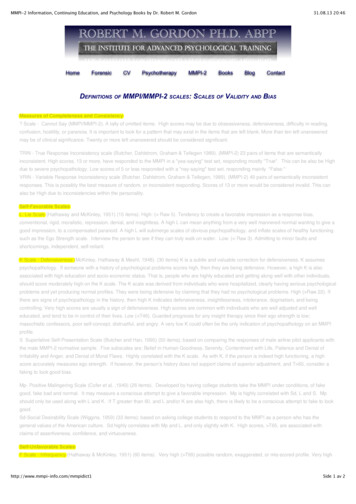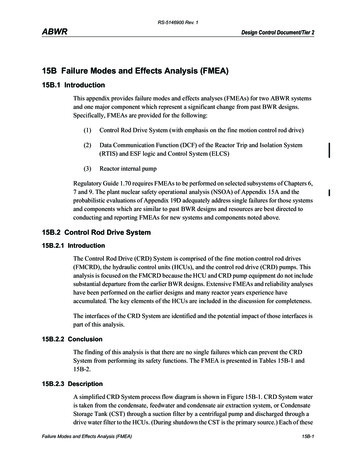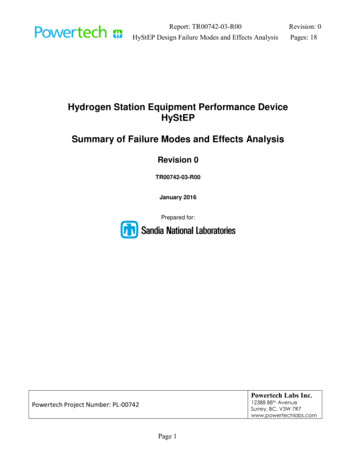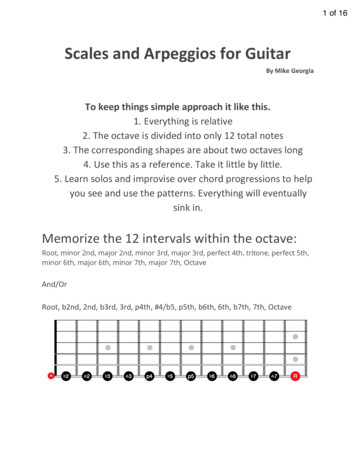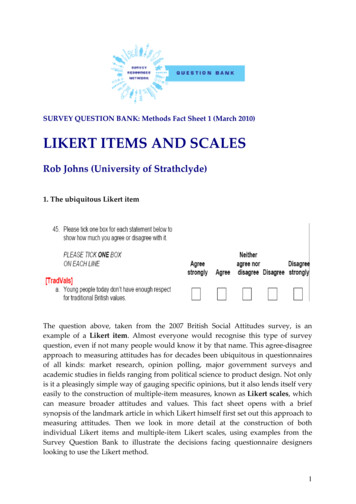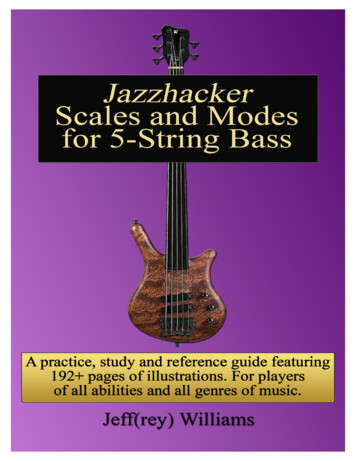
Transcription
Jazzhacker Scales and Modesfor 5-String Bass(Standard Tuning, BEADG)Jeffrey WilliamsSAMPLE EBOOKPlease feel free to share this 38-page sample ebook with all other musicians andmusic students!Note that the full ebooks include 196 pages, featuring 192 full-page illustrations of 16 scales and modes in all 12 keys; seeJazzhacker.net or your favorite ebook store. Thanks for respecting the hard work of the author.Copyright 2004-2012 Jazzhacker Ebooks, All rights reservedCover photo courtesy Warwick GmbH & Co Music Equipment KGThanks to Rita Toews (yourebookcover.com) for implementing my cover design.(The ISBN of the full Jazzhacker Scales and Modes for 5-String Bass ebook is 978-0-9887464-2-8)
Jazzhacker EbooksJazzhacker Scales and Modes for 5-String BassJeff(rey) WilliamsTable of ContentsIntroductionAbout the AuthorThe Jazzhacker FormatJazzhacker Scales and ModesNotes on the FingerboardScales and Modes in CScales and Modes in C# (Db)Scales and Modes in DScales and Modes in D# (Eb)Scales and Modes in EScales and Modes in FScales and Modes in F# (Gb)Scales and Modes in GScales and Modes in G# (Ab)Scales and Modes in AScales and Modes in A# (Bb)Scales and Modes in BIntroductionThis music practice, study, and reference guide decodes 16 of the most useful and popular scales and modes, in all 12 keys ofOccidental music, so it is applicable to any and all genres of Western music: Classical, jazz, fusion, blues, rhythm and blues(R&B), soul, funk, reggae, Latin, rap, hip-hop, trip-hop, pop, rock, rock ‘n roll, punk, metal, rockabilly, gospel, country,country/western - and beyond! Scales and modes are crucial building blocks of music, and your favorite music can be foundwithin these scales and modes.The Jazzhacker format displays an entire fingerboard with position markers (i.e., frets, or the point of correct intonation onfretless instruments) and note names and intervals, along with scale and mode names and formulas, all at a glance. The big,bold, easy-to-read illustrations are perfect for use with all fretted and fretless acoustic or electric guitars and basses. Teacherscan build courses around Jazzhacker Ebooks or use them to supplement any other teaching, and players and students canbrowse and explore at their own pace. Please visit Jazzhacker.net for auxiliary study material, PDF ebooks, and info aboutrelated paper books and apps.About the AuthorBorn and raised in Philadelphia, Pennsylvania, USA, I am a technologist and amateur bass player, living (at the time of thiswriting ;) in Colorado Springs, Colorado, USA. The Jazzhacker project resulted from my efforts to increase my ownunderstanding of scales and modes and (strangely enough ) benefited from design skills cultivated during my years of workas an embedded software engineer. I have also gained a bit of expertise in regards to ebook and app design, production, andmarketing, so if you are an author or musician developing ideas for ebooks or apps and would like to partner with me and mycrew, please contact me via Jazzhacker.net.Best wishes in all of your musical endeavors!PEACEJeff(rey) WilliamsNovember 2012
The Jazzhacker FormatLeveraging upon the geometric design of the fingerboard of most stringed instruments, the proprietary Jazzhacker formatessentially divides the fingerboard into upper and lower halves, at the octave, and combines the physical locations of all notesof a scale or mode with the note names and their interval values (i.e., their harmonic distances from the root).The scale or mode name and formula is at the top of the page; it indicates the intervals (i.e., the harmonic distance from theroot) of the chromatic notes included in the particular scale or mode. The labels (Open), (0 / 12), and 1 / 13 through 12 / 24 areposition markers (i.e., frets, or the point of correct intonation on fretless instruments) and represent open strings or frets 0 or12, 1 or 13, 12 or 24, etc, up to 24 frets (i.e., two octaves). A 0 fret (if present on an instrument) is equivalent to (Open), andthe same notes (an octave apart) are present at all position markers (because the notes on the fingerboard repeat starting at theoctave).The roots and their octaves are in circles (interval 1/8) and the other notes of the scale or mode are in squares, with theirintervals (2nd, flatted 3rd, 3rd, 4th, sharped 4th, 5th, etc) next to them, according to the scale or mode formula. The notes alsoform patterns on the fingerboard, and these patterns will become familiar - graphically, tactilely and audibly - as you study andpractice them.During scale or mode practice, a musician will typically play from a root to the next octave, following the sequence indicatedby the scale formula. However, a musician may want to extend this at times by playing all the scale notes under a particularfinger position, beyond the bounds of the current scale (or mode), or perhaps shift and play the scale (or mode) beginning atanother root, up to two octaves away. These practice techniques are easily accommodated with the Jazzhacker format.Jazzhacker Scales and ModesThis section presents a bit of music theory to set the context for scale and mode study. To explore this subject matter further,please check out any music theory publication or website; there are lots of great ones available.Scales and modes are derived from the 12-note chromatic scale that forms the basis of most Occidental (i.e., Western) music.The chromatic scale consists of 8 natural and 4 accidental notes. Accidentals occur between some of the naturals. Anyaccidental may be rendered as flat (½ step lower in pitch than the next higher natural) or as sharp (½ step higher than the nextlower natural). Accidentals are thus enharmonic, e.g., a sharped 4th is identical in pitch to a flatted 5th, a sharped 5th is identicalin pitch to a flatted 6th, etc.The 16 scales and modes decoded in this study guide are (in order): Major (Ionian Mode), Natural Minor (Aeolian Mode),Dorian, Phrygian, Lydian, Mixolydian, Locrian, Harmonic Minor, Melodic (Jazz) Minor, Lydian Flat-Seven, Whole-Tone,Diminished (Whole-Half), Major Pentatonic, Minor Pentatonic, Blues and Blues with Major 3rd. These are among the mostuseful and popular scales and modes for all genres of music.This study guide uses the symbol b to indicate flatted notes or intervals and the symbol # to indicate sharped notes or intervals.Accidentals are rendered as flats if the scale includes a flatted 3rd and as sharps (#4 and #5 only) if the scale does not include aflatted 3rd; all other accidentals are rendered as flats. (This is merely the personal preference of the author; as a musician, youcould encounter accidentals rendered as (or described as) sharps or flats in any context and you should be prepared to handlethem.)- Jeff(rey)
Notes on the Fingerboard
Scales and Modes in C
Scales and Modes in C# (Db)
Scales and Modes in DOmitted from this 37-page sample ebook! Please see the 196-page full ebook at Jazzhacker.net or your favorite ebook store.Scales and Modes in D# (Eb)Omitted from this 37-page sample ebook! Please see the 196-page full ebook at Jazzhacker.net or your favorite ebook store.Scales and Modes in EOmitted from this 37-page sample ebook! Please see the 196-page full ebook at Jazzhacker.net or your favorite ebook store.Scales and Modes in FOmitted from this 37-page sample ebook! Please see the 196-page full ebook at Jazzhacker.net or your favorite ebook store.Scales and Modes in F# (Gb)Omitted from this 37-page sample ebook! Please see the 196-page full ebook at Jazzhacker.net or your favorite ebook store.Scales and Modes in GOmitted from this 37-page sample ebook! Please see the 196-page full ebook at Jazzhacker.net or your favorite ebook store.Scales and Modes in G# (Ab)Omitted from this 37-page sample ebook! Please see the 196-page full ebook at Jazzhacker.net or your favorite ebook store.Scales and Modes in AOmitted from this 37-page sample ebook! Please see the 196-page full ebook at Jazzhacker.net or your favorite ebook store.Scales and Modes in A# (Bb)Omitted from this 37-page sample ebook! Please see the 196-page full ebook at Jazzhacker.net or your favorite ebook store.Scales and Modes in BOmitted from this 37-page sample ebook! Please see the 196-page full ebook at Jazzhacker.net or your favorite ebook store.
The 16 scales and modes decoded in this study guide are (in order): Major (Ionian Mode), Natural Minor (Aeolian Mode), Dorian, Phrygian, Lydian, Mixolydian, Locrian, Harmonic Minor, Melodic (Jazz) Minor, Lydian Flat-Seven, Whole-Tone,

